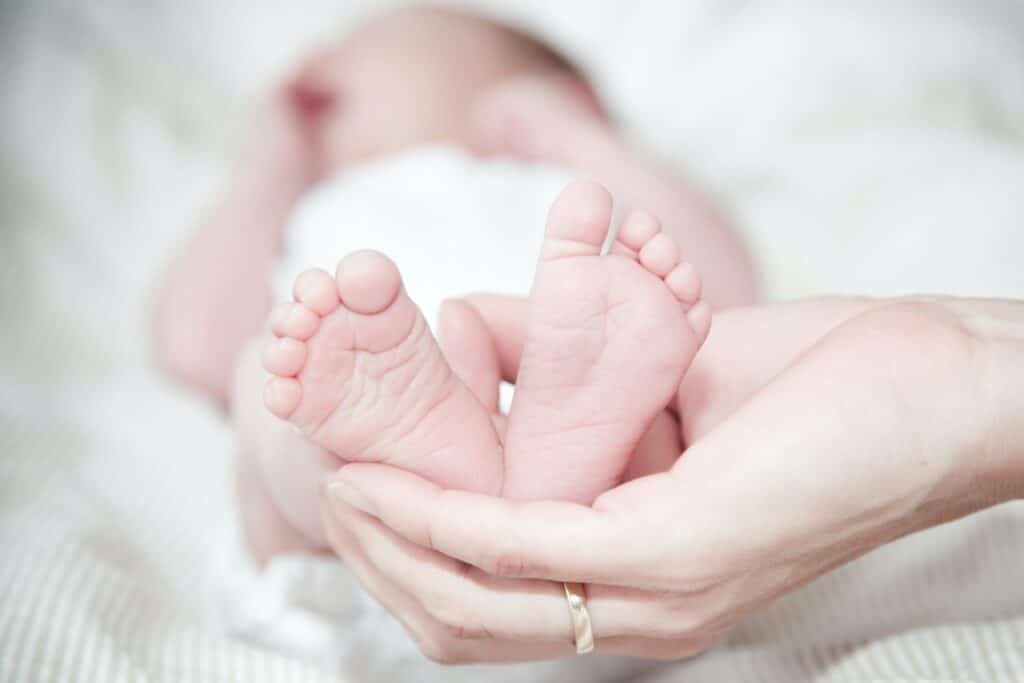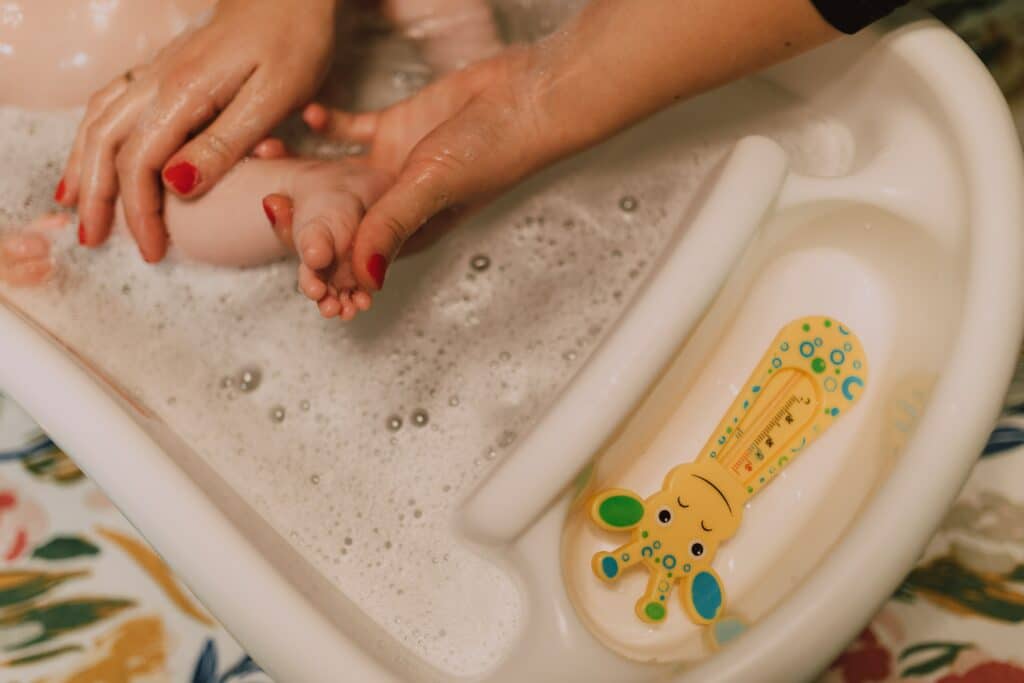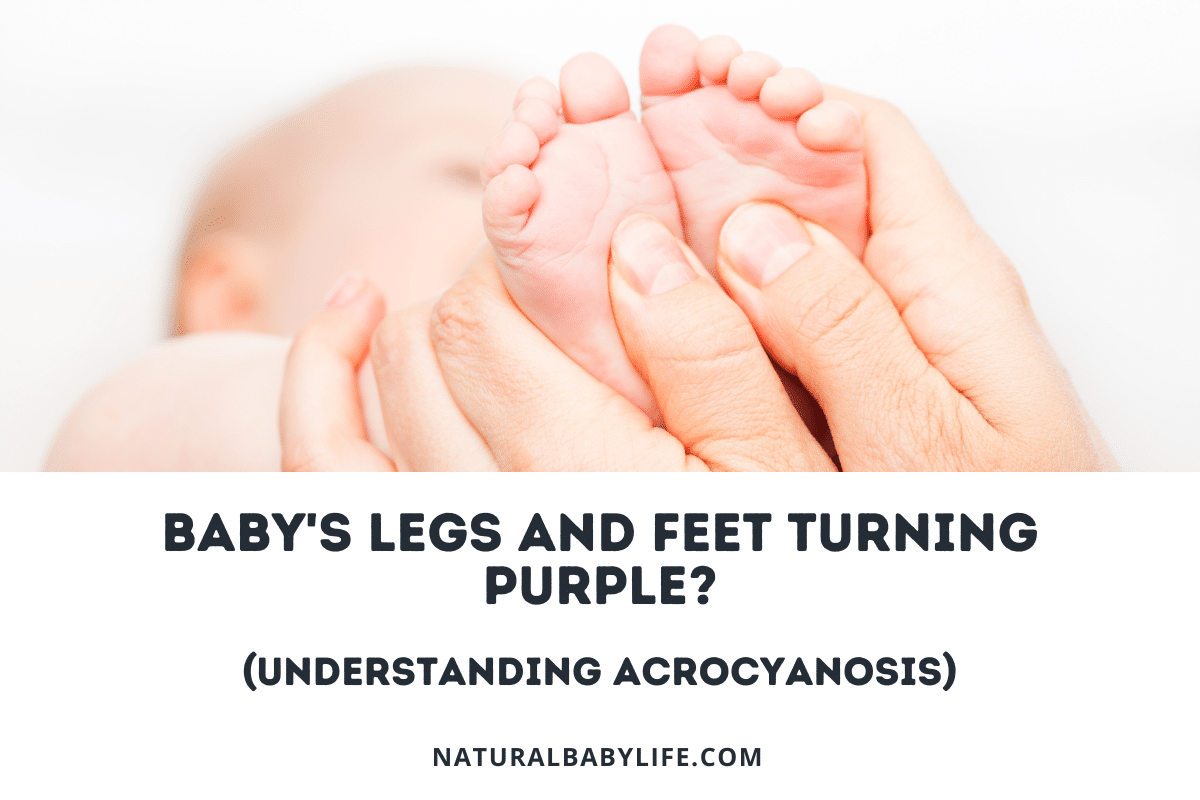Usually, when you think of baby skin, you usually think of the softness and delicious newborn smell, not your baby’s legs and feet turning purple. It’s not unusual for babies to have a temporary purple tint to their limbs at times, it’s important to understand why it happens and what to look for to make sure it isn’t something more serious.
Acrocyanosis causes the hands and feet to have a blue or purple tint. This is common in babies, especially after birth, and is usually nothing to worry about. This happens because blood is being directed to major organs the brain and heart rather than the limbs. Once the blood begins to circulate regularly this will go away.
While acrocyanosis is often a temporary condition that fades away and sometimes reappears, what if it doesn’t? Seeing a skin color change can be alarming, so understanding what to look for can help in case of an emergency.

Table of Contents
What is cyanosis in infants and children
Acrocyanosis is a condition that causes the limbs to have a blue or purple tint and is quite common in newborns in the hours after birth. Acrocyanosis happens in the first few hours of life because blood is concentrating on getting to the baby’s vital organs, like the heart, brain, or kidneys, before getting to the limbs.
There are two types of acrocyanosis: primary and secondary.
Primary acrocyanosis is attributed to color changes in limbs on both sides of the body. Meaning that if the left side is off-color, then so is the right side of the body. Secondary acrocyanosis only affects one side of the body and is generally associated with pain and is cause for concern.
Why do baby hands, legs, and feet turn purple
The human heart functions as a pump that carries blood to all areas of the body through the use of veins and arteries, which make up the circulatory system (of which you have two: pulmonary and systemic). Blood carries oxygen throughout the body and is returned to the heart where it is then sent to the lungs to collect oxygen and carry it throughout the body.
Repeat.
So, what happens if the cycle is interrupted somehow?
Sometimes that can mean illness, alert an emergency situation, or it can be from something as simple as exposure to cold temperatures. Others it’s just acrocyanosis. But what exactly causes acrocyanosis?
That depends on whether the condition is primary or secondary.
Primary acrocyanosis
Primary acrocyanosis in newborns is generally due to the blood beginning to circulate normally focusing on vital organs first and extremities second in the first hours of life. It’s generally benign, meaning not harmful, and will often go away on its own. If you notice this after baby’s hospital stay following birth, it’s generally due to constricted blood vessels caused by exposure to cool temperatures (blood vessels aren’t carrying enough oxygen to the limbs).
Have you ever noticed your hands turn purple when you’re out in the cold without gloves? Primary acrocyanosis responds to warm temperatures and movement (like a warm bath or rubbing the limbs).
Secondary acrocyanosis
Secondary acrocyanosis can be painful and is often a symptom of underlying medical conditions. In this case, you may notice only one hand or foot experiencing discoloration. Secondary acrocyanosis can be a sign of other serious health conditions like vascular diseases or blood disorders, certain cancers, or infections.
Raynaud’s disease, a condition that causes the hands and feet to become discolored in response to cold temperatures or even stress, is often a cause of secondary acrocyanosis.
Symptoms of acrocyanosis in babies
Symptoms of acrocyanosis include:
- Blue or purple-colored fingers and toes
- Cold, sweaty hands or feet
- Low skin temperatures
- Slow blood flow
- Swelling in the hands or feet
- Normal pulse
Oftentimes symptoms of acrocyanosis will improve with warm temperatures and movement and worsen with cooler temperatures.
Acrocyanosis, while usually a harmless, temporary condition, can sometimes be mistaken with other conditions:
- Cyanosis: If a blue color is appearing around the mouth or face, or around the whole body it could be a signal that the baby is not getting enough oxygen. Do not ignore this. This can be caused because the baby’s red blood cells aren’t carrying as much oxygen as needed and can be serious. Contact medical help immediately.
- Mottling: If a baby’s skin looks blotchy, marbled, or web-like this is often described as “mottling.” It’s not uncommon in babies who are premature or ill. If you notice mottling of the baby’s skin, contact your baby’s healthcare provider immediately as this could be a sign of circulation problems, infection, or heart problems.
- Raynaud’s Disease: A condition that can cause the hands and feet to overreact to cold temperatures or even stress. Hands and feet may feel numb or painful as a response to external stimuli (like wind or cold). Severe Raynaud’s is rare, and this most commonly doesn’t affect one’s overall quality of life. However, Raynaud’s is associated with illness, injury, or even a medication side effect.
How long do newborn hands and feet stay purple
It’s not unusual for a newborn’s hands or feet to look purple for up to 24-48 hours after birth.
Acrocyanosis is not a persistent condition in newborns or infants, so if it doesn’t go away then medical assistance should be sought to rule out other causes.
Is it normal for newborn hands, legs, or feet to turn purple
Acrocyanosis, or discoloration of the limbs in newborns, is quite common and usually resolves within 24-48 hours following birth. This is caused due to baby’s circulatory system adjusting to life outside the womb; the baby’s blood is busy circulating to vital organs first before reaching the limbs causing the legs or feet to look purple.
This condition can also occur after temperature changes-like after a bath or being outdoors in cool weather.

What if purple hands, legs, and feet turn blue?
At times, the discoloration caused by acrocyanosis can be described as casting a purple, blue, or dark tint on a baby’s skin-especially in the limbs. In darker-skinned children, this can be hard to spot. Most times this is no cause for grave concern and is often the result of temperature changes or other benign factors.
If the baby has darkened limbs but normal-appearing skin elsewhere and the baby is breathing fine then this is typically no cause for concern if the skin returns to normal in a timely manner.
However, if the baby’s skin appears darkened and blue then this could be a signal that insufficient oxygen is getting to the baby’s lungs or the blood supply is sluggish. Seek medical attention.
Oxygen is what makes blood turn red and red blood cells without oxygen will have a blue color (cyanosis).
If the baby has a bluish appearance over the entire body, this can be a worrisome sign that the blood is lacking sufficient oxygen. It is especially critical to seek medical attention if this symptom is coupled with trouble breathing.
Check for a hair tourniquet
If any of your baby’s extremities look swollen or discolored, do a quick check to see if they’ve become tangled in a long piece of hair.
Loose hair can tightly wrap itself around a baby’s toes, fingers, feet, and even limbs. It can even cut off circulation to the affected area, so something simple can end up very serious.
Baby’s hands and feet turn purple after the bath
Acrocyanosis can occur after bath time. One of the causes of primary acrocyanosis is temperature changes causing a restriction of blood vessels, which may cause a temporary darkened (blue or purple) tint to the skin, particularly in the hands, feet, and legs.
Simply get your little one warmed up and monitor the change in color to be sure it changes back to normal.
What if baby’s legs turn purple when crying
It is common for babies to appear discolored (like blue or purple) when they’re crying; this is called peripheral cyanosis. Cyanosis is a condition that describes an oxygen restriction to the blood cells causing them to appear blue. Blood flow to the lungs has been reduced and therefore retains a bluish tint due to lack of oxygen.
Cyanosis can occur:
- During crying
- After waking
- After a feeding
- After a bowel movement
- If the baby is dehydrated

Baby’s legs and feet turning purple in carrier
This is likely a cause of poor circulation. You may want to adjust positioning in the carrier and be sure that it’s the proper size for the baby and that any straps are not excessively tight.
Baby’s legs turn purple when held
Again, this is likely the cause of an underdeveloped circulatory system causing some minor discoloration. If baby’s skin returns to normal after changing their position, then it’s likely nothing to worry about.
What if there is a purple spot on the baby’s foot or leg
This can be something as simple as a bruise or as serious as meningitis.
Meningitis is a life-threatening illness that often has a “pinprick” rash or purple, bruise-like marks anywhere on the body. If you notice a spot like this on baby’s body (foot, leg, or anywhere) accompanied by other symptoms, seek medical help immediately.
Other symptoms of meningitis include:
- Bulging, tense soft spot
- High temperature (be warned that temperature could be normal or low in babies under 3 months old)
- Sleepy/lethargic/not easily woken
- Fast or difficulty breathing
- Shivering
- Rash (purple marks or bruises on the body)
- Diarrhea
- Cold hands or feet
- Pain or irritability from pain
- Stiff body with jerky movements
- Floppy or lifeless body
- Blotchy skin
- Irritability, high-pitched or moaning cry
- Vomiting
- Loss of appetite
- Unusual grunting
Babies who are ill with meningitis should be given immediate medical attention as this condition is serious. Learn more about meningitis and septicemia here.
While usually a minor discoloration in baby’s hands, legs, and feet is nothing to worry about, trust your instincts. If discoloration doesn’t improve, worsens, or is accompanied by other troubling symptoms then don’t hesitate to call your healthcare provider for further help and instructions. Your child may need medical attention in some cases.
When to worry about purple or blue feet or legs
The best cues to let you know that something is seriously wrong are if there is a change in your baby’s breathing or if you see any discoloration around the mouth, lips, or tongue. These are clues that your baby needs help getting enough oxygen and needs emergency care.
Try warming or massaging your baby’s limbs if you see discoloration. If they don’t return to normal, check in with your pediatrician.
Finally, listen to your baby. If they’re unusually fussy, this can be an indication of pain. If it accompanies other symptoms, it’s worth a call to your doctor.











